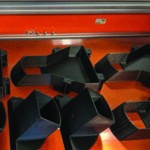In an effort to reduce the costs and time required to demonstrate regulatory compliance of 3D printed parts, Stratasys worked with the National Center for Advanced Materials Performance (NCAMP) under FAA oversight to create a public domain database that includes standardized processes, equipment, and materials for meeting qualification standards. The database will even the playing field a bit for suppliers looking to get their 3D printed parts into aerospace and other industrial applications.

Qualification and certification
There are many 3D printing technologies and materials so qualification is difficult. A regulatory agency can’t just certify a specific material because that same material could express different properties by being printed on different machines, or even printed on the same machine with different settings. For qualification, repeatability is everything. “Until you have that level of repeatability, it’s very challenging for a certifier to look at a technology and trust it,” said Scott Sevcik, VP of manufacturing solutions at Stratasys.
By working with aerospace manufacturers and certification authorities, Stratasys hopes to “foster a collective understanding of core requirements necessary for a qualification path for AM parts.” They chose to base the qualification process off of their F900 3D printer and ULTEM 9085 resin due to the wide adoption of the FDM process and the material in various industries.
The database covers the machine calibration and operation as well as material selection that will lead to the highest-quality parts. Chris Holshouser, technical director of advanced manufacturing development for the National Institute for Aviation Research (where NCAMP is located), explains, “Without that commonality and that consistent stepping off point, there’s a lot of variability and user influence that can go into driving a very different outcome with the same printer.”
Traditionally, qualification and certification are accessible only to large firms that have millions of dollars to spend on the processes. “That’s limited qualification of additive to some very big names with deep pockets to pursue qualification and take on that risk,” Sevcik stated. He’s hopeful their database will empower smaller companies, saying, “This provides a public qualification, data and processes that can be leveraged by anyone to significantly reduce their investment and uncertainty in their own qualification program.” Holshouser claims that using the database can cut the qualification process from eight months to a mere 20 days.
Of course, this is a smart move by Stratasys because it encourages suppliers to purchase Stratasys equipment and materials, though Sevcik clarifies that that’s not the only option: “Rather than installing the equipment and running that qualification program, they can go to a supplier and say, ‘We are producing parts against this specification. We need you to show compliance and your equivalency,’ and then that data flows up to the certification authority.”
Stratasys is reaching out to other qualification and standards organizations to create more databases, including one with SAE International for their AMS7100 fused filament fabrication process.











